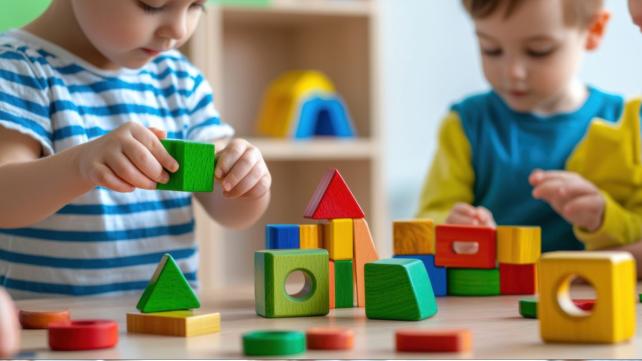
Fine motor skills are an important part of daily life. They are used to perform small tasks with our hands and fingers, such as brushing our teeth, eating, and getting dressed. When these skills are sharpened, tasks become easier and more enjoyable. For young children, building fine motor skills early assists them become more independent and self-reliant. With time and encouragement, children can have strong hand control and coordination. This article will list some benefits, strategies to develop fine motor skills, the role of adults, and Islamic perspective on child development.
Benefits of Fine Motor Skills
1. Increases Autonomy and Confidence
It is significant for children to be independent so they can take care of themselves and feel self-assured in their capabilities. Also, children can handle daily routines without always needing assistance from adults, siblings, and classmates such as zipping up a jacket or packing their backpack.
Confidence assists children to believe in themselves and try new activities without fear. As a result, they are more likely to keep learning and solving issues on their own. For instance, when children learn to tie their own shoes, they feel proud and excited to repeat it again, which builds both skill and confidence.
2. Hand-Eye Coordination
Developing hand-eye coordination assists children complete tasks more smoothly and precisely. This is accomplished when the eyes and hands collaborate to complete an activity. In addition, it enhances their capability to concentrate, control movements, and succeed in activities. For instance, when a child catches a basketball or throws it into the hoop, they strengthen their
hand-eye coordination and enhance their control and timing.
3. Self-Care
Developing self-care skills assists children become more independent and accountable for their daily needs. Also, it increases their self-esteem as they learn to handle tasks like dressing, eating, and grooming on their own. For example, a child who buttons their shirt before arriving at school learns to care for themselves and manage their time better.
By practicing fine motor tasks regularly, children gain significant life skills that help them grow, learn, and feel better about themselves.
Strategies to Develop Fine Motor Skills
There are a couple of skills and interesting activities to assist children to develop their fine motor skills:
1. Hand Dominance: Having a chosen hand to achieve most tasks with better control. For example, drawing with crayons on a big paper.
2. In-Hand Manipulation: Shifting and modifying a little object around using one hand only. For instance, turning puzzle pieces around to fit them precisely into the puzzle piece.
3. Pinch and Grip Strength: Utilize small muscles in their hand and have enough strength to complete sharpened movements. For example, using a pencil for a long duration in the classroom.
4. Pincer Grasp: The thumb and index finger collaborate to grip an item. For instance, using cutlery.
5. Bilateral Coordination: Using both hands in a synchronized way to complete different tasks. For example, cutting along lines with scissors for an arts and crafts activity.
6. Hand-Eye Coordination: Use both hands and eyes together in a synchronized motion to reach, grip items, and place them precisely in a specific angle or position. For example, catching and throwing a softball. Also, it has the capability to have tiny and accurate movements smoothly and rapidly. For instance, using construction toys to build and create different objects.
The Role of Adults
It is recommended for teachers to have several fine motor skill activities within the daily school lesson to ensure that young students develop fine motor skills. The advantages of having teachers embedding fine motor skills within the classroom are children will learn to follow rules, collaborate with other classmates by taking turns and sharing items in order to accomplish the task. As a result, young children will have a higher likelihood to have gained communication skills, teamwork, persistence, and perseverance.
Indeed, teachers have an important role in assisting young children develop fine motor skills. It is encouraged for teachers to have fine motor skill exercises within the lesson plan and achieve their academic learning goals for their young students.
Parents can apply different strategies for their young children to gain fine motor skills. First, parents can model tasks such as holding a pencil crayon properly or buttoning clothes so that children can observe and learn. Second, parents can use positive words and support their young children. It is a higher likelihood that they will be more committed to gaining fine motor skills when they feel encouraged and safe. Moreover, parents can have routines and clear directions for their young children. For instance, parents can arrange a specific time daily for arts or crafts activities that improves their fine motor skills. Some examples of art activities are playing with bigger beads, solving simple puzzles, building blocks, and cutting shapes using child-safe scissors.
Teachers and parents can help young children develop fine motor skills by encouraging them to use a variety of different regular motor skill activities daily.
Islamic Perspective on Child Development
The Quran stated:
“So, surely with hardship comes ease.”
(Surah Ash-Sharh 94:5)
It means that every obstacle an individual faces is followed by support and relief from Allah. Hardships are not forever and that ease always comes, despite not being immediate. This verse encourages patience and hope during difficult times.
Indeed, children may face difficulties when learning fine motor skills in different activities. This specific Quranic verse has spiritual encouragement and reassurance that obstacles are part of growth. With practice and patience, skills become easier over time.
Fine motor skills play a large role in a child’s early growth. When children use their hands and fingers to explore, create, and play, they develop significant capabilities that support their growth. These little actions help them express themselves and engage in the world around them. Parents and teachers can support this learning with easy, hands-on activities, and encouragement. With time and practice, children grow more self-reliant and skilled, creating positive and initial experiences in their early years.



Add new comment